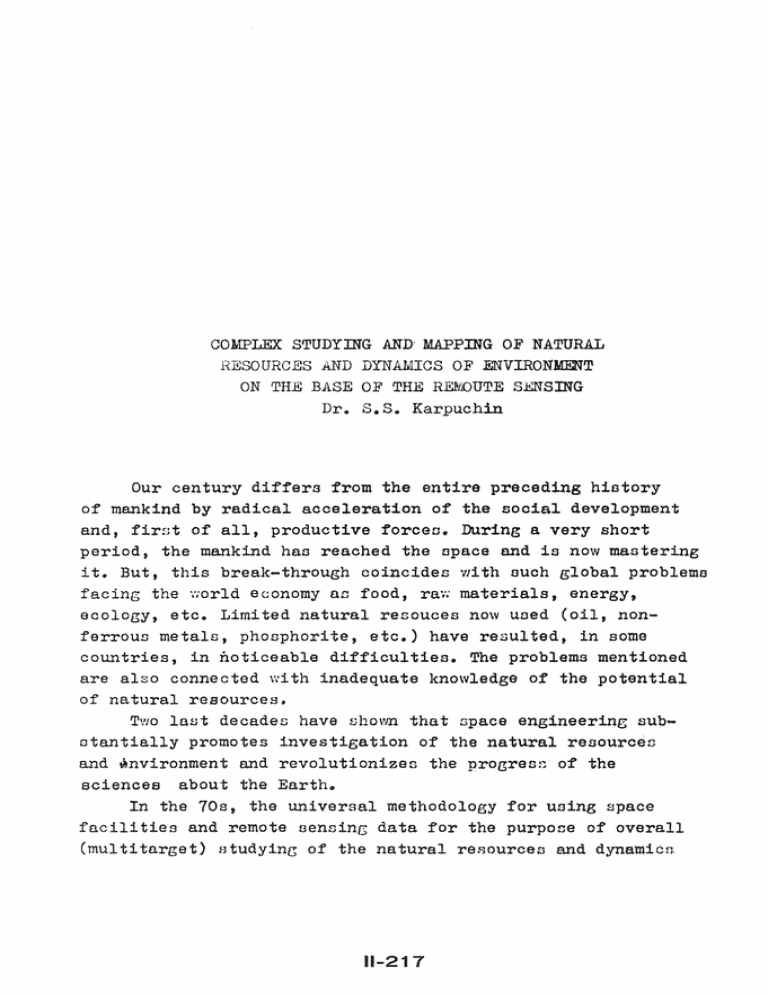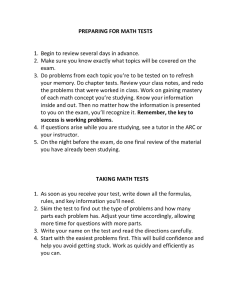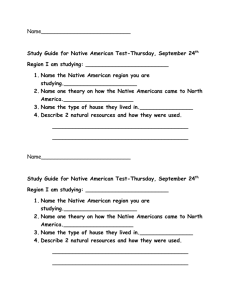COMPLEX STUDYING AND' MAPPING OF ... HESOURCES DYNAMICS ENVIRON:M:mT
advertisement

COMPLEX STUDYING AND' MAPPING OF NATURAL HESOURCES AND DYNAMICS OF ENVIRON:M:mT ON THE BASE OF THE RID/DUTE SENSING Dr. s.s. Karpuchin Our century differs from the entire preceding hiotory of mankind by radical acceleration of the social development and, firr:~t of all, productive forceo. During a very short period, the mankind hao reached the space and is now mastering it. But, this break-through coincides with such global problems facing the \·-·orld e eonomy an food, ra·;; materials, energy, ecology, etc. Limited natural resouces now uoed (oil, nonferrous metals, phosphorite, etc.) have resulted, in some countries, in noticeable difficulties. The problems mentioned are also connected with inadequate knowledge of the potential of natural resources. Tv1o last decades have shown that npace engineering substantially promotes investigation of the natural resourcen and ~nvironment and revolutionizeo the proBres:~ of the sciences about the Earth. In the 70s, the universal methodology for using space facilities and remote oenning data for the purpose of overall (multitarget) Btudyine of the natural resources and dynamicn 11-21 of natural and ~ocio-economical even tn eave rinc to ~:pacea radically ne~ ~ay based na turnl tudien it possible to s ons of on the basic of one data base (sa ed ) one me multiaspect dological-technoloeical method so as to ob (multifunction) products. s s Emergence 8 re new (unus ) to succeso in s The , resource, ec ogi to the nece~~ni of searchinG pa.rti v;ayc the camp n new progress of the USSR economy greatly East use of large territorieo in Siberia on abounding in the natural resources~ Information solution problems of further economical development me these regions us studies is not jj the complex studying and mapping resources the use of space data promo operative implementation of p d information support economical development of particular regions of our country. To start the complex studying and mapping of the natural resources all over the territory of the USSR, adequate technical facilities are created and the problemn of methodology and technology are studied. The methodology of overall studying and mapping of the natural resources is based on the interdependent tions of the natural resources a reeion by tation of space means of thematically-oriented depending on the analys this traditional studies. the re d as a me mapping with studying the resources is a s it possible to compile a space data wide use ....r. an D system u 1 information about spatial location of the natural resources in the region study. should be remembered that maps themse s are not a single target but arc an optimum, for the time , mearu1 of recording on to insure its practical use and 8torage. The most important stages in etudying and mapping of the regional natural resources preparation a sc ific-tcchnical detail de;;>ign involving tailed elaboration of target orientation of ree±onal stigations in the of the camp studying and mapping resources defining of the composition map series; obtaining space data required; tar-branch processing of remote sensing materials; elaboration of map series programs; tation of space photos; carrying out of field check investigations; making of compilation manuscripts; editing, preparation for reproduction, reproduction of map·s. Investigations concerning the complex studying and mapping the resources une of space data promote a ous most importruit natural resources of the study. Such approach makes it posnible to use all experience accumulated and materials collected by traditional methods in order to obtain information about the present state and dynamics of the natural resources. ExperienGe shows that ne\v information about the natural resources during thai complex Gtudylne and mapping ar0 ob·tn.ined and utilized long before completion of the entire cycle of cartographic work. Therefore, scope, sequence of execution, and planning of work on the complex studying and mappi.ne; of the n~.tnra1 "r~":}90ilrceG me:-:t, fi~~s-t of all, the requi.r~ments for obtaining new information about the natural resource potential of the region concerned. The composition of cartographic records advisable for making during the complex studyine and mapping of the natural resources, the scope of inveotigations are dictated by the u 1 of the natural conditions and problems of economic development of the reeion with due reeard for the naturaleconomical zoning of the terri tory. The number of mapB in a series may be from several to tens of maps. Studying and mapping of mineral, land, forest, fodder, and ,,','ater resources are the main goals of the complex ntudying and mapping o! the natural resources. To attain each goal, a group of maps are compiled as a rule. For instanc.e, for studying and mapping of mineral resources worked out are geological, tectonic (geological structural) maps as well as fracturing tectonic, ring ntructure, quartenary sediment, oil-gas zoning, and other maps, land use (agricultural use), soil, soil-amelioration, agricultural production state mapn ao well as of territorial maps of agro-industrial complex, etc., are made for land resources. As for forest, these maps include geobotanica, forestry, forest dynamic, and other maps. Fodder studyine requires compilation of hydrological, hydrogeological (surface and ground waters), and other mapa. Besides, the complex studying and mapping of the natural resources dictate compilation of natural conditions maps including maps of recommendation and assessment nature such as: geomorphological map; landscape map; engineering geological map; engineering assessment map; exogenic proces~: map; nature protection map, etc. as well as a group of maps on socio-economic topics. Worked performed for complex studying and mappinB of the natural resourcen of particular re~ions of the USSR teotifies to that utilization of space data substantially reduced the time cf compilation of thematic mapc alonc;nide better vitality and scientific and practical value. Very important are the complex 8tudying and mapping of the natural resources of poorly investigated and undeveloped territories nince theoe territories are just the place for full implementation of advantagen of space data reoulting from their high information yield due to large field of view, spe~ifics II optical eeneralization, and high reDolution, mul tia~;pect interpretation, comprehen.sivenes::i and immediatenes:.~ of compilation of informational cartographic producto. The complex studying and mapping of the natural resources prenent a unique pos~.;ibili ty to accelerate revealing and usaee of the natural wealth and provide reliable support for efficient perform~!ce of prospecting and design studies and for solution of the problem of nature protection. During the 3tage space natural Btudie;_~ of becoming a reality, the mankind became in a position to see object of the natural very complex in their r;enenis and which the mankind han tried to "reconstruct" on maps by means of traditional and nome timer; inadequate methods. Cartographic modelling of natural objectc han been justified at that level of l<:nowledge hen no information has been available about the properties of the objects as oxpresBed by their appearance. The analysis of images of the natural objecto on apace photon has reveal a certain dincrepancy bet·\~:·ecn the previous gnosiological conntructions (modeln) and the reality observed. From the other hand, such analysis has given an impetus to a new understanding of structural opecifics of the Earth surface. The necesnity han arioen to revise the available methods of obtaining information from remote senoing data traditionally used for interpretation of aerial photos and to viork out a different modelling basis for usine space photos in inter-branch investieationn. The ner.· poosibili ty of observation and studying of complex natural and socio-economical objects on space photos in different ncales and in their dynamics maker.; it posnible to examine the ennence of objects by their optical imaeeo. These imagen are explicit on the photos and changing from one scale to the other (durinc, enlargment) performed by means of image differentiation resultr: in showing the structure of objects under study proceeding from the general to the particular, from the entity to the part. Such approach to studying and mapping of the natural objecto in not common for the geological-geographical sciences and,cs result, the complex studying and mapping of the natural resourcen judgine from space data leadn to making new kinds of thematic maps or to elaboration of ne\Y type ler;ends of traditional map;:-: depending on nontraditional or improved classifications of objects. To better practical value of maps, elaborated during the complex ctudying and mapping of the natural resources of a particular resion, assessment and forecasting aspectD acquire greater importance, the specifics of the present otate of the natural resources are presented with due regard for existing and probable human actions, the steps recommended are represented to facilitate rational use and protection of the natural resources. The complex studying and mapping of the natural resources greatly improve the exioting methods of map appearance elaboration of unified systems of symbols meeting the requirements of joint use of conjugated map, and rational techniques are v;orked out for map reproduction. To reduce the amount of computations arising from interbranch processing of space data during the complex studying and mapping of the natural resources, it is advisable to utilize computing and dedicated digital hardware. Use of digital methods makes it possible to fully implement the capabilities of the complex stu~ying and mapping of the natural resources and substantially increase the number of applications of thin method. In future, the materials resulting from the complex studying and mapping of the natural resources will create the basis for elaboration and implementation of computerized de..ta nyntems for land ma.nagement aimed at operative storage, re~ular refreshment, and out-put of information about the natural resources of' the region to the users concerned both in digital and sraphical form, Work performed in various region:J of the USSR in the field of complex studying and mapping of the natural resources has made it possible to standardize systematization of a great amount of branch-oriented scientific inform~~~io!l about the natural resources of several regions. Wide testing and analysis of the results o.f scientific and experimental ·,vorl< make it ponsible to underline their great practical value. The results of the complex otudying and mappine of the natural resources are uned for improvine the methods of mineral prospectin~, bettering the u.: c of land 't;ater, and fodder resources and are also utilized in \~:orking out the desicns of larse hydrotechnical projectn and location of localities. So, the use of space data for complex studyine and mappine of the natural resources and the dynamics of the reeional environment is aimed at solvins the problems of re0ional economic development and presents the example of utilization of the space and space technology in peaceful purposes. The methodological-technological basis of the complex studying and mappine of the natural reoources 'norked out in the USSR depending on the use of space date can find many applications in information support of nolution of resources and ecological problems and planning of rational nature manae;ement both in the develop and developing coWltries. 11-223





